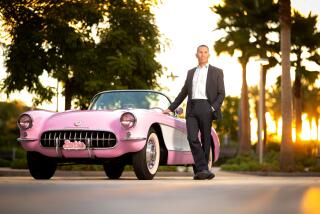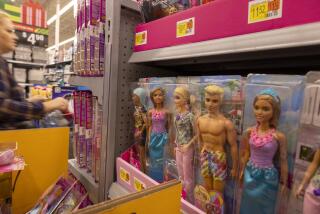Trying to Get a Comment From Barbie
Iâve been trying all morning to ring up Barbie, to ask her whether she won or lost in court the other day, because to tell the truth, I couldnât figure it out.
A Los Angeles federal judge said that yes, a Utah artist could go ahead and commit free speech with his photographs of Barbie in a tortilla, Barbie in a blender, Barbie in a toaster, and call it art. Actually, the artist calls his series âFood Chain Barbie,â and he sells it on postcards and prints.
What I want to ask Barbie is, is this a good thing for her, or a bad thing? Being shown as a link on the food chain isnât pleasant, but her hair does look perfect, and the artist spelled her name right.
Mattel, Barbieâs earthly maker down in El Segundo, tried to convince the judge that âFood Chain Barbieâ is copyright infringement, and to Mattel that is always a bad thing. Over the years, Mattel has tried to hammer the law down on other artists, musicians, publishers, Web masters who Barbiecize their work, with mixed results.
But Barbie is bigger even than the worldâs biggest toy maker that made her. She and that burger chain have both topped 1 billion sold. Her picture appeared on postage stamps, putting her in the rarefied company of George Washington and Tweety Bird. In the last few years, I think she has had more mentions in the L.A. Times than Colin Powell.
If she were a real person, she would be a public figure. Of course, if she were a real person, she would also be living in an iron lung because no one with that surreal superstructure and those creepy feet could breathe or walk in this planetâs gravitational field.
And a public figure not even as famous as Barbie has to put up with abuse that the rest of us donât. Itâs the trade-off that the âumble little people like to exact from the renowned, without which theyâd be insufferably happy.
So when Larry Flyntâs skanky skin magazine ran a cartoon of Jerry Falwell doing unspeakable things some years ago, Falwell sued. The Supreme Court told him to put a sock in it; the cartoon was porn parody and satirical free speech. A while back, the two of them, Falwell and Flynt, ended up having a buddy-fest over coffee, proving that the rich and famous, even when theyâre not toys, really are different from you and me.
I got Barbieâs phone number from my erstwhile colleague Scott Harris, who cultivated Barbie as a source after her old boss Dick Riordan, the man who restructured Mattel, was elected mayor of Los Angeles. But she hasnât picked up the phone, and I suspect she has caller ID and knows itâs me.
I canât say that I blame her; she and I were never exactly close.
The things this artist did to Barbie as protest art, we did for fun. My favorite was Marie Antoinette Barbie--whack goes her head. We liked Joan of Arc Barbie, but that was only good for one afternoonâs play, and open flames were guaranteed to bring somebodyâs mother running.
Apart from that, Barbie was a pretty dull toy. She didnât do anything but sit there. A bookend just sits there, too, but at least it does honest work. Clotheshorse Barbie changed from one fabulous ensemble to another and waited for Ken to show up. All her later incarnations--doctor, astronaut, president--they fooled nobody.
Barbie is a perfect empty canvas. Everyone knows her. Because she was white, blacks and Asians and Latinos used her to vent about mainstream racism. Because she looks like a 14-year-old boyâs wet dream, women could use her to fault the obsession with the passive, fatuous, ornamental female. Because she and her wardrobe are a bottomless marketing cornucopia, she is the ideal target in a âbuy meâ culture that values us not as citizens but as consumers.
All of which is why the artist Tom Forsythe chose Barbie as the medium for his message. Forsythe hails from Kanab, Utah. I donât know much about Kanab except that it has a wonderful animal sanctuary, but I would lay odds that Barbie, like red rocks and blue sky and the Almighty, is everywhere in Kanab, too.
The day after the judgeâs ruling, my colleague Rob Wishart got a call from a woman at a newspaper in Paris. She was challenging The Timesâ point that a typical American girl owns two Barbies.
Itâs 10 Barbies, not two, the woman said. It turns out that it is a two-Barbie average, but this is exactly what makes Barbie a very scary woman, and why Tom Forsythe can go ahead and put her head on a fondue fork: because, even for a moment, even in the dull month of August, Barbie--the doll, the tortilla filling, the symbol--can be as monumental on the mental landscape of a woman in Paris as is the Louvre.
Patt Morrisonâs column appears Mondays and Wednesdays. Her e-mail address is [email protected].
More to Read
Eat your way across L.A.
Get our weekly Tasting Notes newsletter for reviews, news and more.
You may occasionally receive promotional content from the Los Angeles Times.











